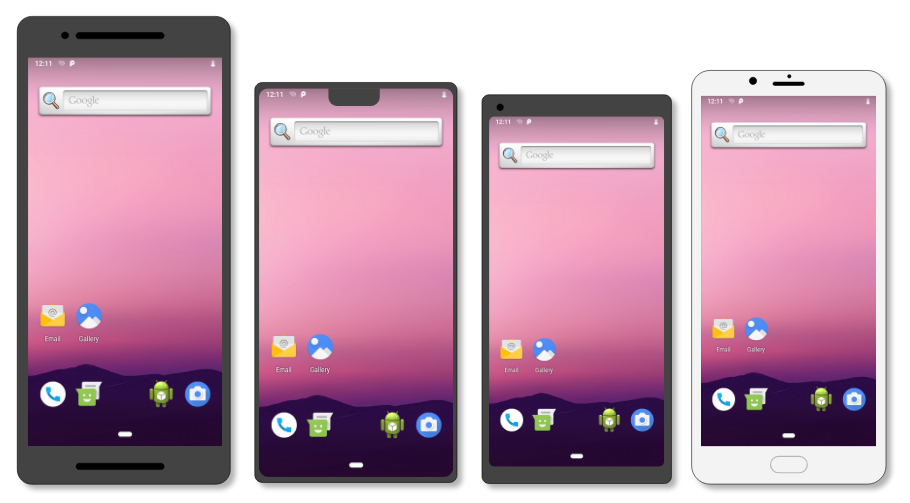Une image système générique (GSI) est une implémentation Android pure contenant du code de projet Android Open Source (AOSP) non modifié, qui s'exécute sur divers appareils Android.
Les développeurs d'applications peuvent installer et exécuter les dernières GSI Android pour tester des applications sur divers appareils Android existants et les utiliser à différentes étapes de publication de l'OS Android, y compris les versions Preview développeur et les versions bêta. L'ajout de GSI à vos processus de validation et de test présente des avantages potentiels supplémentaires :
- Couverture plus étendue des tests sur un plus grand nombre d'appareils réels
- Temps supplémentaire pour résoudre les problèmes de compatibilité des applications
- Opportunités supplémentaires de résolution des problèmes de compatibilité Android signalés par les développeurs d'applications
Le projet GSI est Open Source. Il contribue à améliorer l'écosystème Android en offrant plus de moyens d'améliorer la qualité des applications et des systèmes d'exploitation avant chaque version d'Android.

Les GSI intègrent les mêmes fonctionnalités système principales pour tous les appareils sur lesquels elles sont installées. En d'autres termes, une GSI n'inclut pas les personnalisations du fabricant de l'appareil. C'est pourquoi vous pouvez rencontrer des différences de comportement dans les situations suivantes :
- Interactions impliquant l'interface utilisateur
- Workflows demandant des fonctionnalités matérielles plus récentes
Vérifier la conformité de l'appareil
Les GSI ne peuvent fonctionner que sur les appareils présentant les caractéristiques suivantes :
- Bootloader déverrouillé
- Prise en charge de Treble
- Lancement avec Android 9 (niveau d'API 28) ou version ultérieure (les appareils mis à niveau vers Android 9 peuvent être compatibles ou non avec les GSI)
Pour déterminer si votre appareil peut utiliser les GSI et pour identifier la version de l'OS que vous devez installer pour les GSI, procédez comme suit :
Vérifiez la prise en charge de Treble en exécutant la commande suivante :
adb shell getprop ro.treble.enabled
Si la réponse est
false, l'appareil n'est pas compatible avec les GSI et vous ne devez pas continuer. Si la réponse esttrue, passez à l'étape suivante.Vérifiez la compatibilité entre les versions en exécutant la commande suivante :
adb shell cat /system/etc/ld.config.version_identifier.txt \ | grep -A 20 "\[vendor\]"
Dans le résultat, recherchez
namespace.default.isolateddans la section[vendor].Si la valeur de cet attribut est
true, l'appareil est entièrement compatible avec le kit de développement natif pour les éditeurs (VNDK) et peut utiliser n'importe quelle version d'OS plus récente pour les GSI que la version d'OS de l'appareil. Dans la mesure du possible, utilisez la dernière version d'OS disponible pour les GSI.Si la valeur de l'attribut est
false, cela signifie que l'appareil n'est pas entièrement conforme au VNDK et qu'il ne peut utiliser la GSI que si la même version d'OS est présente sur l'appareil. Par exemple, un appareil Android 10 (API version 29) qui n'est pas compatible avec le VNDK ne peut charger qu'une image GSI Android 10.Le type d'architecture du processeur GSI doit correspondre à l'architecture du processeur de l'appareil. Pour déterminer l'architecture de processeur adaptée à l'image GSI, exécutez la commande suivante :
adb shell getprop ro.product.cpu.abi
Reportez-vous à la sortie pour déterminer l'image GSI à utiliser lorsque vous flashez votre appareil. Par exemple, sur un Pixel 5, la sortie indique que l'architecture du processeur est
arm64-v8a. Vous devez donc utiliser le typearm64de GSI.
Télécharger des GSI
Il existe plusieurs façons d'obtenir des GSI, selon vos besoins de développement :
- Les GSI des previews Android et les GSI Android avec GMS peuvent être téléchargées sur la page des versions GSI.
Pour les images GSI prédéfinies sans applications GMS, téléchargez les images à partir du site CI AOSP :
Pour générer des GSI Android sans GMS, téléchargez le code source depuis AOSP et créez vos GSI.
Installer une GSI
L'installation d'une GSI dépend de l'appareil. Contactez le fabricant de votre appareil pour connaître les outils et les procédures exacts. Pour les appareils Google Pixel tels que le Pixel 3 et les modèles plus récents, vous pouvez procéder de plusieurs manières pour installer une GSI :
- Flasher manuellement les images GSI : consultez les conditions requises pour flasher les GSI.
- Utiliser les mises à jour système dynamiques pour les appareils qui exécutent déjà Android 10 ou une version ultérieure : consultez la page des mises à jour système dynamiques.
Envoyer un commentaire
Les GSI sont conçues pour vous aider à valider vos applications sur Android. Vos commentaires sur les images, les outils et le processus d'activation des GSI sur vos appareils sont les bienvenus.
Pour nous signaler des bugs ou demander des fonctionnalités, utilisez le composant dédié au suivi des problèmes pour les GSI.

